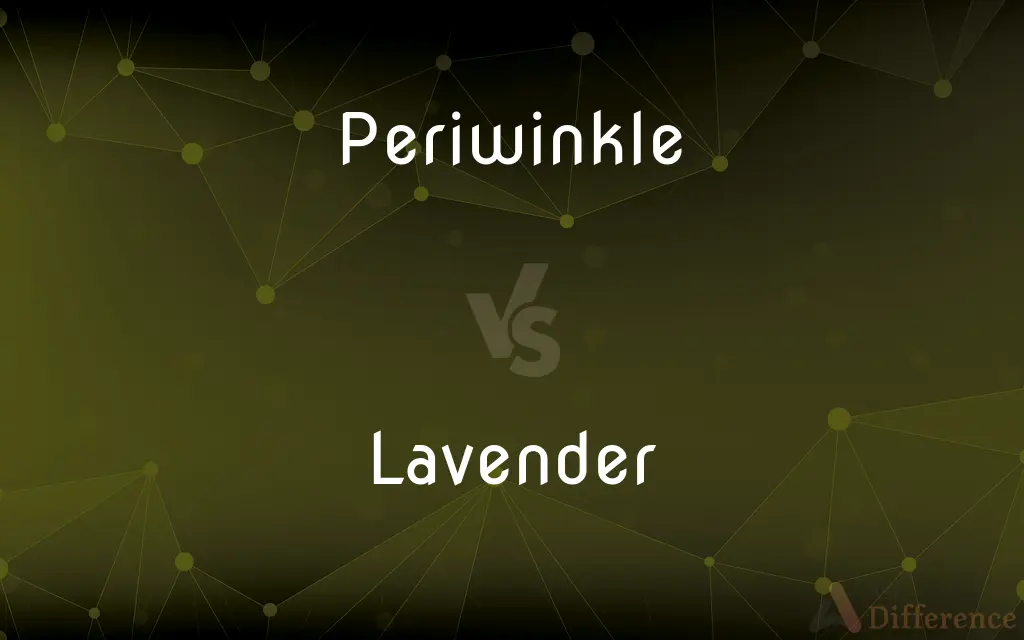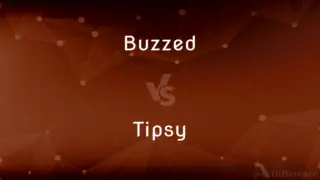Periwinkle vs. Lavender — What's the Difference?
By Tayyaba Rehman & Maham Liaqat — Updated on March 8, 2024
Periwinkle is a color that blends blue and purple with a soft, pastel hue, associated with the periwinkle plant's flower, while lavender is a lighter, more delicate shade of purple, named after the lavender flower and known for its calming associations.

Difference Between Periwinkle and Lavender
Table of Contents
ADVERTISEMENT
Key Differences
Periwinkle, with its mix of blue and purple, has a cool and soothing feel, often used in designs and clothing to evoke a sense of serenity and space. Lavender, being predominantly purple with a faint touch of blue, is associated with elegance, refinement, and luxury, often used in fashion and decor for a touch of sophistication.
The color periwinkle is said to inspire creativity and a dreamy, whimsical vibe, making it popular in creative spaces and children's rooms. Lavender, on the other hand, is often associated with tranquility and relaxation, frequently used in bedrooms and spas to promote a calming atmosphere.
In floral symbolism, the periwinkle plant is associated with enduring and eternal love, as well as memories, making it a popular choice in wedding bouquets and sentimental arrangements. Lavender flowers symbolize purity, silence, devotion, and caution, with a long history of use in perfumery and aromatherapy for its soothing properties.
When it comes to gardening, periwinkle refers to a small, evergreen plant known for its ground-covering ability and star-shaped, blue-purple flowers, thriving in various conditions. Lavender refers to a fragrant, perennial herb with spike-like purple flowers, prized for its aromatic oil and ability to attract pollinators like bees and butterflies to the garden.
Comparison Chart
Color Tone
Soft blend of blue and purple
Light, delicate shade of purple
ADVERTISEMENT
Associations
Creativity, spaciousness, whimsy
Elegance, tranquility, refinement
Symbolism
Enduring love, memories
Purity, silence, devotion
Usage in Design
Inspires creativity, used in serene spaces
Evokes calmness, used in elegant settings
Floral Meaning
Everlasting love, nostalgia
Purity, calmness, grace
Compare with Definitions
Periwinkle
Used to create a sense of openness and creativity.
The artist chose a periwinkle backdrop to evoke a dreamy landscape.
Lavender
Lavender is a delicate purple with a faint blue undertone.
The lavender fields bathed in sunlight created a breathtaking view.
Periwinkle
Periwinkle is a soft blend of blue and purple.
The periwinkle dress had a gentle, calming effect at the summer gathering.
Lavender
Known for its calming and soothing properties.
The lavender-scented candles filled the room with a sense of peace.
Periwinkle
Reflects the color of the periwinkle flower.
The garden was dotted with the delicate hues of periwinkle blooms.
Lavender
Adds a touch of sophistication to interiors and fashion.
The lavender tablecloth transformed the dining area into an elegant space.
Periwinkle
Often associated with enduring love and memories.
The periwinkle bouquet brought back fond memories of their first meeting.
Lavender
Lavender is prized for its fragrant flowers and essential oil.
The fresh lavender sprigs added a fragrant aroma to the handmade soap.
Periwinkle
Offers a whimsical touch to clothing and accessories.
Her periwinkle scarf added a playful twist to her outfit.
Lavender
Lavender plants are loved by bees and butterflies.
The lavender garden was alive with the buzzing of busy bees.
Periwinkle
An Old World plant with flat five-petalled, typically bluish flowers and glossy leaves. Some kinds are grown as ornamentals and some contain alkaloids used in medicine.
Lavender
A small aromatic evergreen shrub of the mint family, with narrow leaves and bluish-purple flowers, used in perfumery and medicine.
Periwinkle
Another term for winkle
Lavender
A pale blue colour with a trace of mauve
She wore a lavender silk dress
Romantic designs in old-fashioned tones of primrose, lavender, and rose
Periwinkle
Any of various marine snails of the family Littorinidae, having thick, cone-shaped, whorled shells, especially Littorina littorea, an edible species of the North Atlantic Ocean.
Lavender
Perfume with lavender
Lavendered sheets
Periwinkle
The shell or the flesh of any of these snails.
Lavender
Any of various aromatic plants of the genus Lavandula of the mint family, native chiefly to the Mediterranean region, especially L. angustifolia, having clusters of small purplish flowers. Lavender is widely cultivated as an ornamental and for its essential oil, used in perfumery and cosmetics.
Periwinkle
Any of several shrubby, trailing, evergreen plants of the genus Vinca, especially V. minor, having glossy, dark green, opposite leaves and flowers with a blue, funnel-shaped corolla.
Lavender
The fragrant dried leaves, stems, and flowers of this plant.
Periwinkle
Any of several erect herbs of the genus Catharanthus, especially C. roseus, having flowers with a rose-pink or white salverform corolla and a closed throat.
Lavender
A pale to light purple to very light or very pale violet.
Periwinkle
A pale purplish blue.
Lavender
Any of a group of European plants, genus, Lavandula, of the mint family.
Periwinkle
Any of several evergreen plants of the genus Vinca with blue or white flowers.
Lavender
(color) A pale bluish purple colour, like that of the lavender flower.
Periwinkle
Similar plants of genus Catharanthus.
Lavender
A kind of film stock for creating positive prints from negatives as part of the process of duplicating the negatives.
Periwinkle
A color with bluish and purplish hues, somewhat light.
Lavender
(color) Having a pale purple colour.
Periwinkle
A mollusk of family Littorinidae.
Lavender
(politics) Pertaining to LGBT people and rights.
Periwinkle
Of pale bluish purple colour.
Lavender
(transitive) To decorate or perfume with lavender.
Periwinkle
Any small marine gastropod shell of the genus Littorina. The common European species (Littorina littorea), in Europe extensively used as food, has recently become naturalized abundantly on the American coast. See Littorina.
Lavender
An aromatic plant of the genus Lavandula (Lavandula vera), common in the south of Europe. It yields and oil used in medicine and perfumery. The Spike lavender (Lavandula Spica) yields a coarser oil (oil of spike), used in the arts.
Periwinkle
A trailing herb of the genus Vinca.
Lavender
The pale, purplish color of lavender flowers, paler and more delicate than lilac.
Periwinkle
Chiefly trailing poisonous plants with blue flowers
Lavender
Any of various Old World aromatic shrubs or subshrubs with usually mauve or blue flowers; widely cultivated
Periwinkle
Commonly cultivated Old World woody herb having large pinkish to red flowers
Lavender
Of a pale purple color
Periwinkle
Small edible marine snail; steamed in wine or baked
Periwinkle
Edible marine gastropod
Common Curiosities
What is the main difference between periwinkle and lavender colors?
The main difference is in their color composition; periwinkle is a mix of blue and purple with a pastel tone, while lavender is a lighter, more delicate shade of purple.
Can periwinkle and lavender be used together in design?
Yes, periwinkle and lavender can complement each other in design, creating a soft, pastel palette that evokes calmness and creativity.
How do the meanings of periwinkle and lavender flowers differ?
Periwinkle flowers symbolize everlasting love and memories, while lavender flowers are associated with purity, silence, and calmness.
Is there a difference in the care requirements for periwinkle and lavender plants?
Yes, periwinkle is a low-maintenance ground cover that can tolerate a range of conditions, while lavender requires well-drained soil and more sun.
What occasions are periwinkle and lavender colors most suitable for?
Periwinkle is suitable for spring and summer events for its cool, refreshing vibe, while lavender is versatile for any occasion, especially for creating a calming atmosphere.
How do the water needs of periwinkle and lavender plants compare?
Lavender requires minimal water, thriving in dry conditions, while periwinkle can tolerate more moisture and is less drought-tolerant.
How are periwinkle and lavender used in fashion?
Both colors are used in fashion to create soft, feminine looks, with periwinkle adding a playful touch and lavender bringing elegance.
Do periwinkle and lavender attract different types of wildlife?
Lavender is particularly known for attracting bees and butterflies due to its nectar, while periwinkle can also attract various pollinators with its flowers.
Can periwinkle and lavender be used in weddings?
Yes, both colors and their respective flowers are popular in weddings for their symbolism and soft, romantic hues.
Are periwinkle and lavender flowers easy to grow?
Both periwinkle and lavender plants are relatively easy to grow, with periwinkle being a hardy ground cover and lavender being a drought-tolerant herb.
Do periwinkle and lavender have any aromatherapy benefits?
Lavender is well-known for its aromatherapy benefits, including stress relief and relaxation, while periwinkle is not typically used in aromatherapy.
What are some creative ways to use periwinkle and lavender in home decor?
Periwinkle can be used in soft furnishings and wall colors for a serene space, while lavender accents like throw pillows, vases, or scented candles can add a touch of elegance and calm to a room.
Are there any historical uses of lavender that differ from periwinkle?
Lavender has a long history of use in perfumery, medicine, and aromatherapy, while periwinkle has been used traditionally for its medicinal properties, though less commonly than lavender.
What are the best conditions for growing lavender plants?
Lavender plants thrive in full sun, well-drained soil, and prefer dry, less humid conditions.
Can the scents of periwinkle and lavender be combined in products?
While periwinkle is not known for its scent, lavender's fragrance is often used in products, and theoretically, it could be combined with other scents to create unique aromatic products.
Share Your Discovery

Previous Comparison
Buzzed vs. Tipsy
Next Comparison
Hundredth vs. HundredAuthor Spotlight
Written by
Tayyaba RehmanTayyaba Rehman is a distinguished writer, currently serving as a primary contributor to askdifference.com. As a researcher in semantics and etymology, Tayyaba's passion for the complexity of languages and their distinctions has found a perfect home on the platform. Tayyaba delves into the intricacies of language, distinguishing between commonly confused words and phrases, thereby providing clarity for readers worldwide.
Co-written by
Maham Liaqat













































